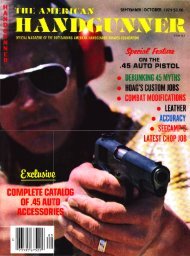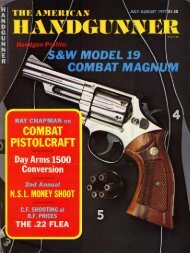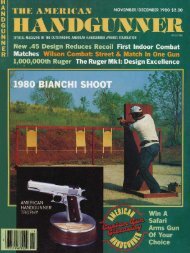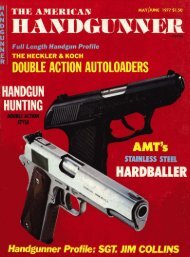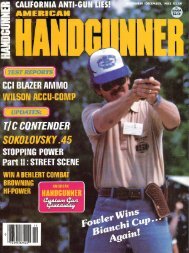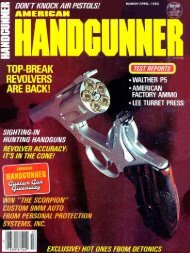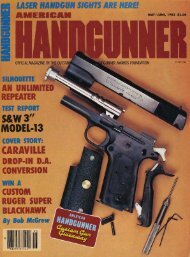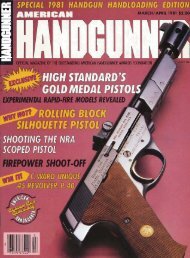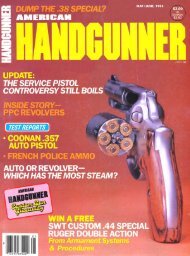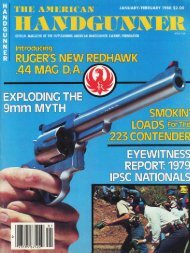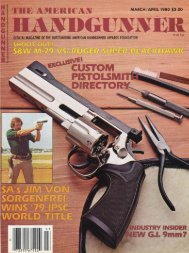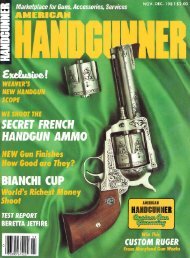ationale was that the expert didn't needtwo hands at a distance, and two handeye level shooting was too slow up close.Prescribed doctrine called for a one handeye level stance (offhand) for long shots,and unsighted point shooting (betweenbelt and shoulder level) for all close speedsituations.Jack Weaver upset the applecart whenhe started using the two hand eye levelstance for all shooting problems. It tookJack awhile to convince the disbelievers,but convince them he did. One handshooting simply could not measure upwhen compared with the newer technique.Whether for deliberate fire orquick speed problems, the WeaverStance proved superior to all others. Thiscould only have been proven in open unrestrictedcompetition, and only underthese uninhibited conditions could suchan idea be conceived and tried in the firstplace.The Weaver Stance is only one exampleof how freestyle practical pistol shootinghas helped inspire, develop and testnew concepts. Forward rake speed holsters,the roll over prone position, theflash sight picture, ambidextrous speedsafeties, the superiority of the autoloadingpistol, fast grab magazine pouches forautos, and speed loaders for wheelgunsare only a few that come to mind; the listis almost endless.As an interesting side light, speedaders were provided for the top breakWebley service revolvers years ago.These were small devices made of leatherand metal which held six cartridges inmuch the same fashion as our modernspeed loaders. Just another old idea thathas been revived and given much widercirculation than at the time of its initialintroduction.While all this development was transpiring,Jeff Cooper carefully began toorganize this new information, along withsome noteworthy older ideas, into a radicallydifferent concept of pistolcraft.Slowly, this growing mass of data wasrefined as other people came up with importantinnovations.Over the years, as these ideas weretested, refined, and proven, Jeff wouldperiodically write them up for the benefitof other shooters. This continual series ofmagazine articles, plus several books,served to spread and popularize theCooper doctrine on pistolcraft. Amongother efforts, his books, "Fighting Handguns,""Modern Handgunning," "Cooperon Handguns," and "The Principles ofPersonal Defense," all served to disseminateand make available the emergingprinciples of modern pistolcraft.Today, thanks mainly to the tirelesswriting and teaching of Jeff Cooper,freestyle combat pistol shooting as a sportand training vehicle has spread across theU.S. and around the world.Twenty years ago it all started inSouthern California with a tiny group ofpioneering shooters. Such near-legendaryfigures as Ray Chapman, Thell Reed,Jack Weaver, John Plahn, and EldonCarl, Combat Masters all, inspired by thechallenge of the radical new concent offreestyle shooting, laid the goundkorfor the sport as it stands today.Already, the next step in this chain (evolution has been forged and is beginnnto make its contribution. The Intern;tional Practical Shooting Confederatiowas formed in 1976 to give direction Ifreestyle practical shooting onworldwide basis. Interest has grown Ithe extent that a governing body was ne
Charter544 Bi^gShot LoadsBy GEORGE C. MONTEany shooters have asked me to rec-M ommend good shot loads for theirrevolvers. Usually they are .38 Specials3r .357 Magnums. It isn't only sportsmenwho ask; many law officers have askedspecifically for an effective load to beused in their short-barreled, hideoutguns. The trouble is that there simplyaren't any truly effective loads for smallguns. There are both factory and handloadsin .38/.357 size that will kill rats andrattlers at short range, but that's about it.There simply aren't any loads effectiveenough for defense use that can be firedin small-size handguns. Not until now,anyway.The advent of the Charter Arms .44Special "Bulldog" revolver changes allthis. No bigger or heavier than manysnub-nose .38s, the Bulldog combines .44caliber with a cylinder long enough tohandle a sizeable quantity of shot withgood effect. So, with a Bulldog in hand, Iwent back over shot load development of20-25 years ago to come out with somethingthat really does the job from thethree-inch-barrel, pocket-size Bulldog.Standard .44 Special cases (especiallythe old balloon-head type) can be loadedwith about %-ounce of shot, but more isneeded. Plastic shot capsules appear tooffer an improvement in the form of alarger shot charge. Unfortunately, itdoesn't work out that way because thecapsules can't be held in the case tightlyenough to withstand recoil. In the lightBulldog, the capsules move forward outof the case to tie up the cylinder, no matterhow heavily they are crimped in place.Four shots, at most, usually less, movecapsules from unfired rounds forwardenough to block cylinder rotation. Thatcertainly isn't acceptable.The only alternative, then, is to use alonger case which will hold more shot.The .44 Magnum case comes to mind, butit isn't enough longer to help much. EvenAppearance can be deceiving. Plasticshot capsules, although easily available,will not hold up under recoil even underan extreme crimp. Result-cylinder locks.the untrimmed cases I once filched froman ammo plant don't hold enough moreshot to be worthwhile.The .30-40 rim is easily reduced to .44Special dimensions in a lathe, especiallythe fine miniature Sherline unit I use isquick, easy, and accurate. At the otherend of the scale. vou can file them down, .by hand-no problem if you need onlyfive or 10, but a horrendous chore for 50or 100.A belt or disc sander, even a benchgrinder, with a sanding disc in place, offersthe simplest and quickest method.My sander is a small belt unit sold byBrownells for only a bit over $50. It savedme more than that in sweat and frustrationthe first week I owned it.Anyway, take the full-length, .30-40case (easier to hang onto than after trimmingto length) and lay the edge of the rimup next to the speeding, abrasive belt.Use the other hand to steadv vour wrist. , ,Now smoothly roll the case betweenthumb and fingers while touching the rimlightly against the belt. With just a littlepractice, you'll be able to roll it one turnand take off just the right amount withoutmaking the rim egg-shape. Try it. It's notnearly as difficult as you might think.To reduce rim thickness, hold the casehead parallel to the sander, then press itin gently while rotating it smoothly. Hangon tight and don't let the case tip. Two orthree light passes will remove theheadstamp and probably get the rimdown to the correct thickness. Check bytrying it in a .44 Special shell holder.When it slips in smoothly, it's probablythin enough to work in the gun-unlessyour shell holder is oversize. For thetechnically-minded, the final thicknessshould be .055" or a wee bit under. Youcan stop there, but I always bevel the rimedge lightly, rotating the angled caseagainst the sander with a feather-lighttouch. A 45' bevel, half the rim thickness,looks nice. Afterwards, if thefrosted appearance of the sanded rim andhead surface offends you, hit it lightlywith a soft-cloth, buffing wheel and finerouge. The altered head will then sparkle,completely devoid of any headstamp.Now you're' telling me I ruined theprimer pocket; that it's too shallow by theamount sanded off the head. For rifleprimers, yes-but I've yet to encounter a.30-40 case, whose pocket was not stilldeep enough for flush-seating of largeAMERICAN HANDGUNNER JULYIAUGUST <strong>1978</strong> 23
- Page 1: " I THE AMERICANAUNOFFICIAL MAGAZIN
- Page 6 and 7: INDUSTRY INSIDERBy MASSAD F. AYOOB
- Page 8 and 9: -NIARLES C THOMAS-PUBLISHEI- I?r ?I
- Page 10 and 11: -'.. : ,,. . .{b-.$, \:..', -.,.IOO
- Page 12 and 13: SNUBmNOSEDREVOLVER1 FREE: Targets a
- Page 14 and 15: PA DISSENTING VIEW ON MAGAZINE SAFE
- Page 16 and 17: The New PistolcraftAt Jeff Cooper's
- Page 19 and 20: The Evolution ofModem PistolcraftBy
- Page 21: Sykes back in the 1930's. This prov
- Page 25 and 26: Throat opening can be done with cas
- Page 27 and 28: Now you see it trimmed down to mana
- Page 29 and 30: , .- - A --.-ng. As analternative,
- Page 31 and 32: Little is known of his second ventu
- Page 33 and 34: engaging the cartridge case groove
- Page 35 and 36: AMERICAN HANDGUNNER . JULYIAUGUST 1
- Page 37 and 38: II ShootingIll Law EnforcementPart
- Page 39 and 40: neared completion, factory manageme
- Page 41 and 42: Smith & Wesson Model 595107 Rear Si
- Page 43 and 44: By MASSAD F. AYOOBT THE time of the
- Page 45 and 46: when an automatic is adopted. One r
- Page 47 and 48: of WW 296 in CDM cases sparked by C
- Page 49 and 50: Zen, a td, lean, mustached western
- Page 51 and 52: Here's what makesDan Wesson revolve
- Page 53 and 54: Cutter T-1 is the most delicate of
- Page 55 and 56: standing Handgun Hunter Award is Da
- Page 57 and 58: INTRODUCTION TO 39/59(Continued fro
- Page 60 and 61: ''mentioning the fact that, with th
- Page 62 and 63: The .a57 MagnumHE .357 Magnum was d
- Page 64 and 65: Durable liaht weiaht cast aluminum
- Page 66 and 67: exceeds this record of rejection-af
- Page 68 and 69: 1 fire the first shot DA anyhammers
- Page 70 and 71: THE AMERICAN. . . the only magazine
- Page 72:
When your 22 has to do more than it



